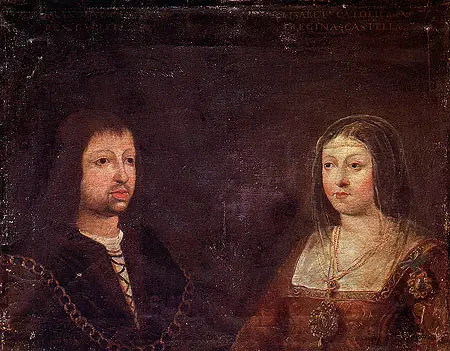December 21: Catherine of Aragon
Today's Tudor treat from the Tudor Society archives is an expert answer to one of our member's questions. Tudor Society members can submit questions for our historians and experts to answer. Try out the Tudor Society with our 14-day free trial - FREE TRIAL HERE
Tudor Society member Angela asked the question "Should Ferdinand of Aragon have insisted on Katherine's return when Prince Arthur died?". Historian Amy Licence, who is the author of Catherine of Aragon: An Intimate Life of Henry VIII's True Wife has answered Angela's question...

This is a complex question, because Katherine's position in England fluctuated during the period of her widowhood between 1502 and 1509. Also, we have to consider the dual impulses in Ferdinand, as a father on one hand, and as a monarch on the other, playing on the international stage, on which all his children were pawns for the furtherment of the Spanish Empire. Out of Katherine’s parents, it was Isabella of Castile who played a more active role in terms of writing to Henry VII before and after her daughter’s wedding, so she was really the commanding figure of the pair until her death in 1505. We must be careful too, with the word “should,” because it is suggestive of hindsight. We know what an awful time Katherine was to have during her widowhood and later, at the hands of Henry VIII, but back then they didn’t know how things would turn out.
Ultimately, the Spanish monarchs wanted an alliance with England. While Henry VII kept dangling the carrot of a second marriage to Henry, Prince of Wales, it was in their interests to keep Katherine in England. In the first year of her widowhood, 1502-3, Katherine certainly suffered, physically and emotionally, but she had Queen Elizabeth of York as a sympathetic figure and she was fairly well provisioned in London, at court, and at Durham House. It was after Elizabeth died in February 1503, that things didn’t go so well for the Spanish Princess. If there was ever a time to recall Katherine to Spain, it was the spring of 1503. Henry VII began casting around for a new wife, and had the bright idea to marry his former daughter-in-law. Isabella objected violently, and actually did try to summon her home, before Henry dropped the plan.
Through the coming years, Katherine’s health and finances fluctuated. She repeatedly sent letters home, asking for help, and messengers too, telling her parents that she was at death’s door, and was living in a way unbecoming to one of her status, but this brought her little relief. Instead of bringing her home, Ferdinand might have sent her some assistance at this point, or leant upon Henry VII to help her more. Until 1505, she lived in hope of a remarriage, but that June, on the eve of Prince Henry’s fourteenth birthday, when the match should have gone ahead, the king made his son repudiate it. This would have been another good time to bring the princess home, as she was now cast into a four-year limbo, without being certain of anything productive at the end. She grew poorer, pawning her plate, unable to pay her servants, and finding it difficult to deal with her staff. She really needed some guidance but little was forthcoming. Instead, she found solace in her religion and became close to her confessor, Fray Diego Fernandez, who was not a completely savoury character and whose influence over her caused trouble at court.
When Henry VII died in April 1509, Katherine didn’t think there was much chance that she would be married to the new king. In fact, the Spanish ambassador Fuensalida told her to start packing her bags to return home. It took her by surprise to hear that Henry VIII was keen to make her his wife, perhaps as a death bed promise made to his father. She also had the advantage of being right there, on the spot, under Henry’s nose, familiar and beautiful, precluding the need for lengthy negotiations with another foreign power. He may have actually developed genuine feelings for her too. If Katherine had given up, or been sent home before this point, she would never have become Queen of England, which had been her aim since early childhood. It might have been more humane for her parents to summon her home t various points while she was suffering, but in terms of her future, it proved to have been the best move to leave her in England. I hesitate to use the old cliché that “whatever doesn’t kill you makes you stronger,” but in this case, Katherine’s years of privation and endurance were rewarded, although they may have contributed to shaping her character in a way that would be significant later on.
Amy Licence is an historian of women's lives in the medieval and early modern period, from Queens to commoners. Her particular interest lies in the late fifteenth and early sixteenth century, in gender relations, Queenship and identity, rites of passage, pilgrimage, female orthodoxy and rebellion, superstition, magic, fertility and childbirth. She is also a fan of Modernism and Post-Impressionism, particularly Woolf and the Bloomsbury Group, Picasso and Cubism.
Amy has written for The Guardian, the BBC Website, The English Review, The London Magazine, The Times Literary Supplement and is a regular contributor to the New Statesman and The Huffington Post. She is frequently interviewed for BBC radio and made her TV debut in 2013, in a BBC documentary on The White Queen. You can follow Amy on twitter @PrufrocksPeach or like her facebook page In Bed With the Tudors. Her website is amylicence.weebly.com.
Her history books include Edward IV & Elizabeth Woodville: A True Romance, The Lost Kings: Lancaster, York & Tudor, Red Roses: Blanche of Gaunt to Margaret Beaufort, Catherine of Aragon: An Intimate Life of Henry VIII's True Wife, Elizabeth of York: Forgotten Tudor Queen and Cecily Neville: Mother of Kings.